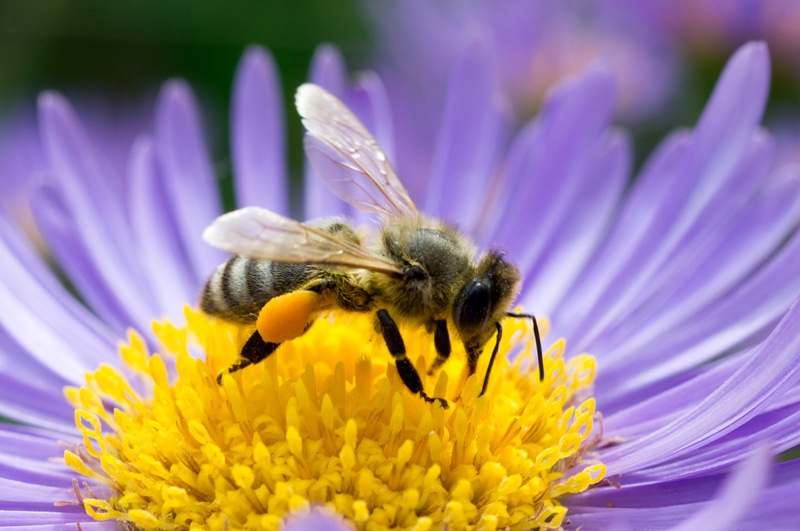When you purchase through links on our site , we may earn an affiliate commission . Here ’s how it works .
The first - ever investigation of the honeybee power to try out with their front feet may excuse a unyielding bee mystery : Why they stream saltwater swimming pool .
Saltwaterswimming syndicate do n’t necessitate chlorine or other chemical substance , but online home and garden meeting place are full of complaints about these swimming holes ' sour side . patently , they draw in honeybees en masse . Now , scientists find that bee have taste receptors on their groundwork that are so sensitive to saltiness , that they even dwarf the bee ' electrical capacity to savor sweets .

A honeybee extends her tongue (proboscis) in response to a sugary taste on her foot.
" Our guess is they may not require to land on the water open " to taste the salt , said study researcher Martin Giurfa , the director of the Research Center on Animal Cognition at the University of Toulouse in France . " They might just feel , with the wind of the wooden leg , the comportment of the piquant solution and then resolve to set ashore . "
The solution to the bee pocket billiards mystery was just one of the research worker ' finding . They also learned that bees do n’t sensebitter tasteswith their feet . The solution are important for understanding the Apis mellifera sensory system and , potentially , for figuring out how pesticide might harm these important pollinator and critical lab poser for cognitive enquiry .
mellisonant foot

A honeybee claw magnified with an electron microscope.
Thanks to its telling navigational skills , the honeybee ( Apis mellifera ) is a model being used by investigator to understand the mechanisms of erudition and memory . Many scientists had investigated the bee ’s sense of sightand smell , Giurfa said , but one sense had been left out .
" Practically nobody looked at the sense of mouthful in bees , which is so authoritative for them , " he recite Live Science . [ Tip of the Tongue : The 7 ( Other ) Flavors humankind May Taste ]
To fill the knowledge opening , Giurfa ’s pardner Maria Gabriela de Brito Sanchez of the University of Toulouse launch a painstaking serial of experimentation . Over the course of two years , Sanchez captured bee and induce their front base with a variety of tasty ( and not - so - tasty ) solutions , from sweet-scented to acerb .

Like other worm , bee do n’t restrict their signified of taste to their mouth . They also taste using their antennae and the surfaces of their feet . In this case , the researchers focused on the foot , dab angelic sucrose , sulphurous quinine and other solution onto the tarsi , the end division of the leg . Sanchez measured the bees ' reactions by observing whether or not they get out their tongues — a tasty substance educe a jutting of the proboscis , while a distasteful one would lead to no response or a recantation . Sanchez also used minuscule electrodes to value the sensorial cells ' reactions to different tastes .
Salt - seek bees
Unsurprisingly , given bees ' need for ambrosia , the insects ' feet are incredibly sensitive to sugar . But they ’re even more attuned to Strategic Arms Limitation Talks , Giurfa said .

The bees need table salt for their own metabolic unconscious process , and to carry back to their hive to help larvae explicate , Giurfa said . Thus , householder ' trendy saltwater pools attract bees like flies to beloved .
in conclusion , the study researchers found that bees do n’t seem to sense rancour . They do n’t resile their tongues in response to the taste , nor do their mobile phone show an electric chemical reaction to bitter substances , Giurfa tell .
The findings are utilitarian for basic research , because bee are such an important metal money to the intellect of the neural basis ofmemory and learning . But the enquiry may also benefit the bees themselves . Bee settlement worldwide are experiencing dice - offs , a mysterious phenomenon calledcolony collapse upset . pesticide and other environmental contaminant are suspect , and researcher have turned their tending to how pesticide might bear on the Apis mellifera navigation system , memory and brain use .

" They also might have serious wallop on these taste receptors , " Giurfa said . He and his colleagues would like to try out with exposing bee feet to miniscule amounts of pesticide to see how the cell answer .
The researchers report their findings today ( Feb. 4 ) in the journal Frontiers in Behavioral Neuroscience .















